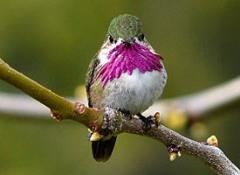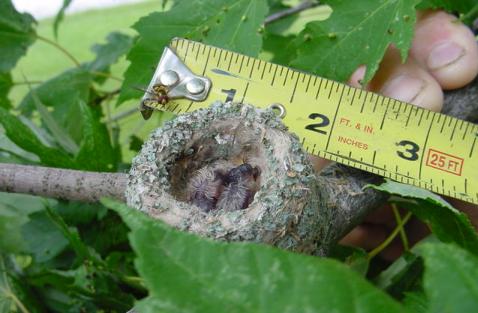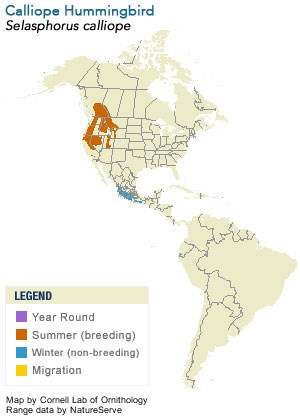 |
|
Male
Calliope Hummingbird
|
 |
|
Female
Calliope Hummingbird
|
The Calliope Hummingbird is the smallest bird
in North America north of Mexico. Despite its small stature, it
breeds in the chilly mountain environments of the northwestern United
States. The male’s magenta burst of rays at its throat make
it a standout from other hummingbirds. Tiny but tough, these birds
are the smallest long-distance avian migrant in the world, spending
winters in Mexico and a few small pockets of the southern U.S.
|
Measurements
Male
Length
3.5 in
9 cm
Wingspan
4.3 in
11 cm
Weight
0.1–0.1
oz
2.3–3.4
g
Female
Weight
0.1–0.1
oz
2.6–3.2
g
Other Names
Colibri calliope (French)
Chupamirto rafaguitas,
Colibrí gorgirrayado (Spanish)
|
At a Glance
|
Habitat
|
Food
|
Nesting
|
Behavior
|
Conservation
|
|
|
|
|
|
|
|
Open Woodland
|
Nectar
|
Tree
|
Hovering
|
Least
Concern
|
Cool Facts
- The Calliope Hummingbird is the smallest bird in North America.
Its mass is about one-third that of the smallest North American
warblers. It is also the smallest long-distance avian migrant
in the world. Eggs may be up to 20 percent of a female’s
body weight.
- Calliope Hummingbird is named after Calliope, the muse of
eloquence and epic poetry, who inspired Homer’s Iliad and
Odyssey.
- Despite their tiny size, these territorial birds may chase
birds as big as Red-tailed Hawks during the breeding season.
- While hovering, these birds‘ metabolic rates increase
to more than 16 times resting level.
- The longest-lived Calliope Hummingbird was at least 7 years
old, when it was recaptured and rereleased during a banding operation
in Montana.
| This little bird generally inhabits the cool environments
of open montane forests, mountain meadows, and willow and alder
thickets, often near running streams. They typically live between
4,000 and 11,000 feet, but may breed at lower elevations, down
to 600 feet. During migration and winter months, Calliope Hummingbirds
are found in chaparral, lowland brushy areas, deserts and semidesert
regions. These birds’ elliptical migration routes mean
that in spring they are more likely to be found in coastal areas,
and in fall, they are in more interior locations at higher elevations.
Birds establish breeding territories in or near open areas with
suitable lookout posts. There appears to be fidelity to breeding
sites year after year. |
| Nectar and small insects. These birds get nectar from cup-shaped
flowers or isolated tubular flowers not sought by larger hummingbirds.
They forage aerially for small insects by “hawking”
— perching on a branch and flying out to catch an insect
in midair. Calliope Hummingbirds also feed regularly at sapwells
created by sapsuckers, probably taking both insects and sap. |
|
Nesting Facts
Clutch Size
2 eggs
Number of Broods
1-2 broods
Egg Length
0.4–0.5
in
1–1.3
cm
Egg Width
0.3–0.4
in
0.7–1
cm
Incubation Period
15–16
days
Nestling Period
18–21
days
Egg Description
Tiny, smooth,
white.
Condition at Hatching
Naked and
helpless.
|
Nesting
Nest Description
Nests are built and tended by females, and are found in coniferous
trees, usually sheltered under an overhanging branch.
|
Nests are a hemispherical cup, often built on an old,
dead pine cone base. They are lined and well insulated with
soft, downy plant materials. The exterior is made up of lichens,
moss, or bark fragments, bound together with strands of spider
web. On the outside, nests are 1.5-1.8 inches wide and just
over an inch high. Calliope Hummingbirds may reuse nests and
nests may be higher if a second is rebuilt upon a first. The
inside of the nest has a diameter of 0.8 inches and is 0.6
inches deep.
 |
|
Hummingbird
babies in a hummingbird nest with ruler
|
|
Male Calliope Hummingbirds defend feeding and breeding territories
against other Calliopes. Possibly due to their small size, they’re
not typically aggressive toward other species. Males mate with more
than one female per season and do not help with nesting activities.
When courting, males hover in front of and slightly above a female.
Females sometimes respond by taking flight and the pair fly in circles,
sometimes joining bills.
 |
|
Courting
Calliope Hummingbirds
|
|
Conservation
status via IUCN
|
|
|
|
Least Concern
|
| Calliope Hummingbird populations have been slowly declining
in the last several decades, according to the North American
Breeding Bird Survey. Partners in Flight estimates a global
breeding population of 2 million birds with 74 percent breeding
in the U.S., 25 percent in Canada, and 100 percent wintering
in Mexico. They rate an 11 out of 20 on the Continental Concern
Score and are not on the 2014 State of the Birds Watch List,
although they are a U.S.–Canada Stewardship species. Recent
winter records in the southeastern United States suggest possible
range expansion of this species, perhaps associated with environmental
changes caused by humans. |

HUMMINGBIRDS.NET
Welcome to HUMMINGBIRDS.NET, a place to learn about attracting,
watching, feeding, and studying the hummingbirds that breed in North
America.
http://www.hummingbirds.net/index.html
|













